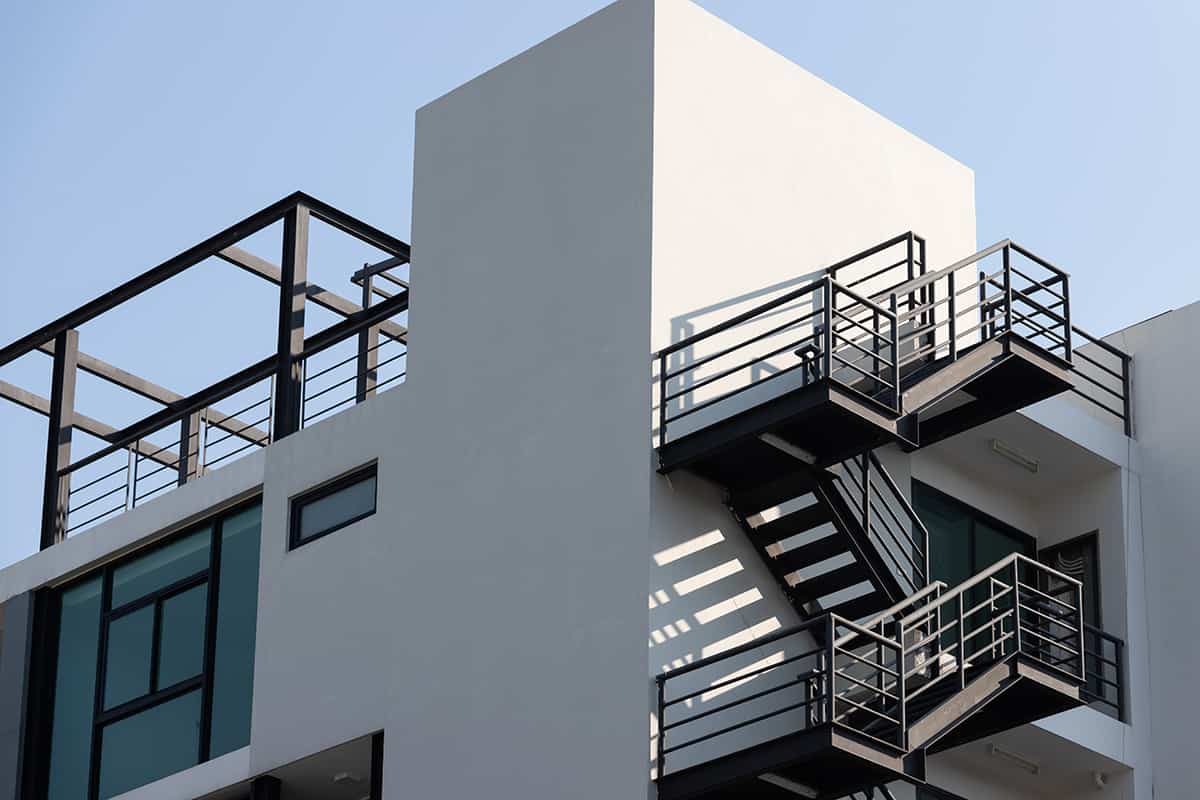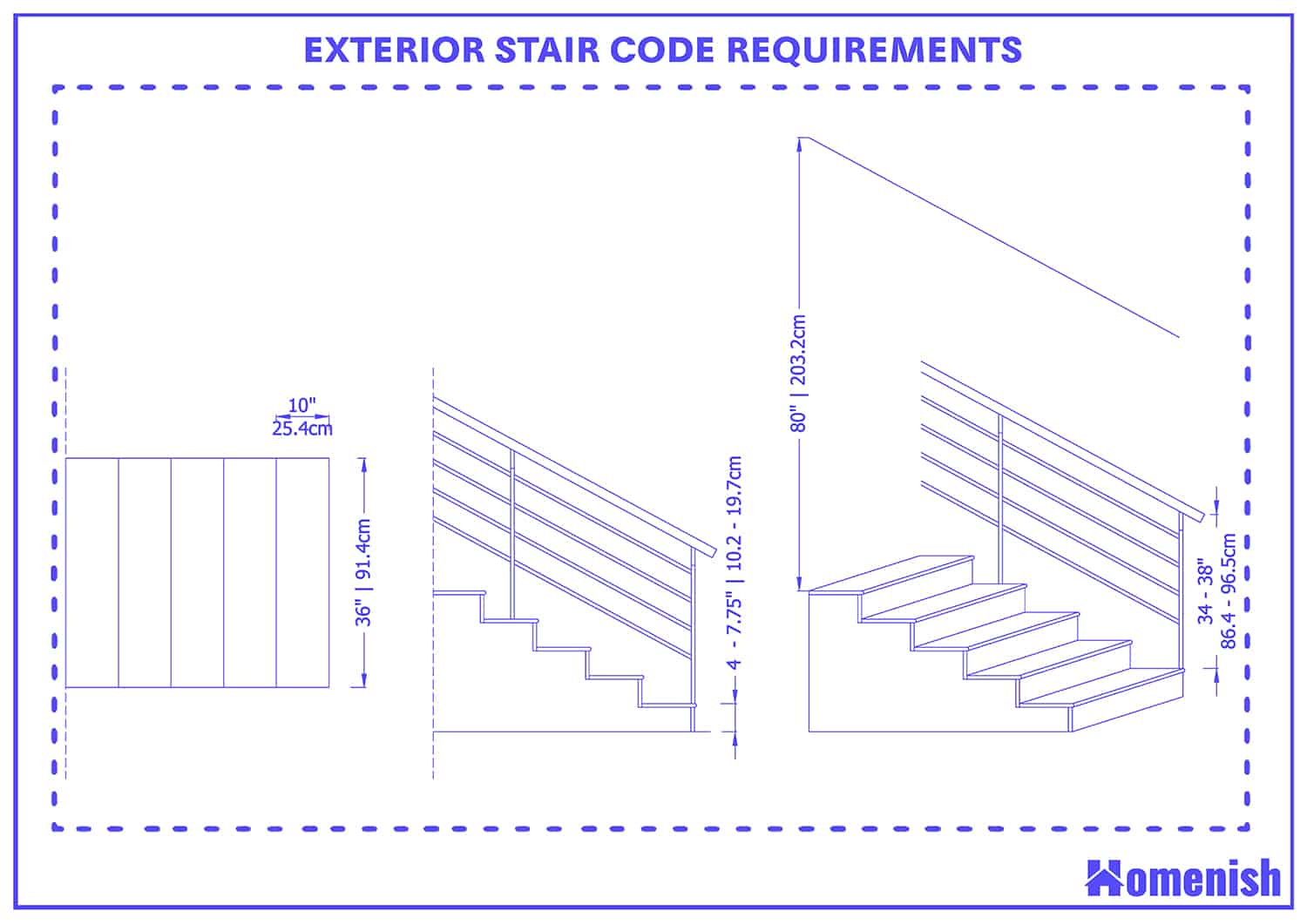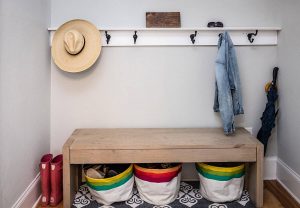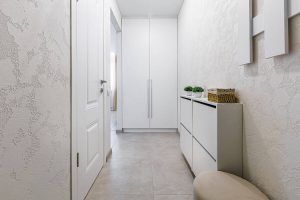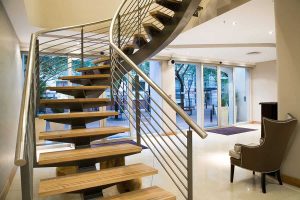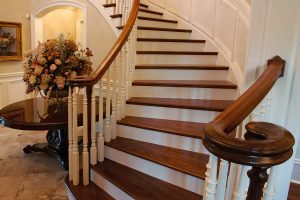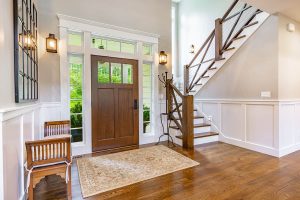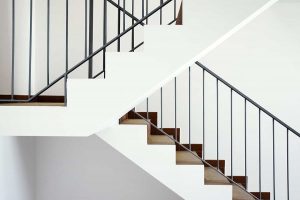If you are building an exterior staircase, for example, a staircase that leads to your raised front door or a staircase down from a balcony area, then you will need to be aware of the code requirements in your area.
Although building codes differ depending on location, stair codes are usually based around International Building Code and the Occupational Safety and Health Administration guidance.
Many of the requirements for exterior stairs are the same as those for interior stairs, which you can learn about in greater depth here.
An exterior stair should have a stair tread with a minimum width of 36 inches, and a minimum depth of 10 inches. The riser in residential and commercial premises must have a minimum height of 4 inches and a maximum height of 7.75 inches.
The height from the stair treads to the ceiling should be at least 80 inches. And finally, handrails on external stairs need to be fitted at a height of between 34 inches and 38 inches above the tread level.
Find the summary of exterior requirements in this diagram below.
Exterior Stair Width Requirements
The required width measurement of a stair tread is a minimum 36 inches. This measurement is taken from the far end of one tread to the opposite end of the same tread, either from left to right or right to left when facing the stairs head-on.
This minimum measurement applies for domestic and residential exterior staircases which serve less than 50 occupants. For example, this could include a staircase on the outside of a single-family home or an exterior staircase on an apartment building that has 6 apartments and no more than 50 occupants.
For commercial and public staircases or residential staircases which serve more than 50 occupants, the minimum width requirement is 44 inches.
Exterior Stair Depth Requirements
For exterior staircases, each tread must be a minimum of 10 inches deep. This measurement is taken from the front lip of a tread to the back corner of a tread, and it is the same irrelevant of which type of material is used to construct the stairs and the treads.
This measurement has been deemed to be the minimum amount of foot space required by most users of the stairs, ensuring that a good grip is achieved when ascending or descending the stairs to minimize possible accident and injury.
Exterior Stair Riser Requirements
The riser on a staircase is the vertical framing component that is used to determine the height between each tread.
For exterior staircases in both residential and commercial premises, the riser must have a minimum height of 4 inches and a maximum height of 7.75 inches. This will mean that each step will be between 4 inches and 7.75 inches higher than the previous step.
These minimum and maximum requirements are in place to help reduce the incidence of falls and miss-steps, since the measurements have been set to allow for a comfortable lifting of the legs between each stair tread.
Exterior Stair Head Height Requirements
To allow for adequate headroom for the users of the stairs, code requirements state that there needs to be a minimum of 80 inches of space from the stair treads to the ceiling height directly above it. This is the equivalent of 6 and a half feet, which will be suitable for the vast majority of people.
To measure the head height, use a straight vertical line going from the nose of each stair tread directly to the ceiling overhead.
Exterior Stair Handrail Requirements
Handrails on external stairs will need to be fitted at a height of between 34 inches and 38 inches above the tread level. This will put the handrail at a convenient and easily accessible height for most users, which they can grab in the event of a fall, or they can use to help guide them safely up and down the stairs.
The size of the handrail should also be taken into account to ensure it is easy to grasp for both small and large hands. If the rail has a circular cross-section, then the diameter will need to measure between 1.25 and 2 inches.
Handrails that are thicker than this will reduce the safety quality of the stairs. For those handrails which are not circular shaped, the perimeter measurements should be between 4 inches and 6.25 inches.
Exterior Stair Drainage
Drainage on stairways is not something you will have put consideration into before if you have only previously built interior staircases. However, this is an important area that should not be overlooked because if you do not ensure adequate drainage, then your stairs can become icy and wet and unsafe to use, or the presence of too much moisture on the stair treads could cause them to rot and become unstable.
If your staircase is made with wooden treads, these should be pressure treated to protect them against water damage, and the structure of the staircase should be such that excess rainwater can drain away from each stair tread.
The direction that each stair tread faces is important when it is made from wood, as this can also help with drainage. When applying wooden stair treads, make sure that the grain is facing downwards. You can check this by looking at the end of a tread to see if the grains are curving upwards or downwards.
When the grain curves downwards, it will encourage better drainage, while if the grain curves upwards, it can encourage water to pool on the surface of the tread. This is not a code requirement, but it is helpful to know in order to make sure your stairs are as safe as possible and do not rot any sooner than they need to.
Another way to help ensure that stairs drain efficiently is to create a slight pitch. If you want to have an inline on your staircase, this will need to be no more than a rise of 1 inch across a 48-inch run.
An incline any steeper than this might be beneficial for drainage, but it would create a hazard for those using the stairs, which is why the maximum incline is set at 1 inch per 4 foot run of stairs.
If you have an existing exterior staircase that is suffering from pooling water, there are ways you can combat this. This is something that typically happens with lumber staircases, especially when they have been installed with the grain pointing upwards.
Over time the wood bows slightly or becomes concave, creating areas where water will pool and form small puddles. If this is happening on your wooden staircase, drill small holes in the wood where the water is pooling, where the water can then escape and drain through.
The drilled holes should be small enough that stiletto shoes do not get caught in them, and this will also help to ensure the look of the stairs isn’t ruined by unnecessarily large holes.
Exterior Stair Landings
Landings are required at the top of exterior staircases in most instances. The landing should be at least the same width as the stair treads, if not bigger, and it should have an incline of 2% to ensure good drainage.
An incline is not necessary if the landing surface is built from decking, which features drainage lines between each plank of wood. Landings are essential when a staircase leads up to a doorway that opens outwards because the landing provides the user with somewhere to safely stand when the doorway is in the open position, without being pushed back down the stairs.
If the entryway at the top of your exterior staircase has a door that opens inwards, then a landing may not necessarily be needed. You should consult your local building code requirements before making a decision on whether or not to have a landing.
Exterior Stair Materials
Exterior staircases can be made from a range of materials, including lumber, concrete, natural stone, metal, and composite. All of these materials will provide good grip on exterior treads, though wood can become slippery if it is not pressure treated and properly maintained. Some building codes require that the first step on any exterior staircase is made from concrete or pressure-treated lumber.
Exterior Stair Maintenance
Any exterior staircase will need to be regularly maintained to ensure it remains safe to use, but the frequency and type of maintenance will differ depending on the type of materials the treads are made from, the local climate, and the amount of foot traffic the staircase receives.
On many materials commonly used for treads, such as natural stone, masonry, and lumber, a buildup of algae will make the stairs very slippery and a dangerous hazard to use.
To prevent algae from building up, pressure wash the stairs at least once a year and even more frequently in areas that are prone to this type of growth. You can also buy chemical mixes that can be applied to stairs to stop algae from growing.
If snowfall or freezing temperatures are expected, always treat your stair treads with salt to prevent ice from forming and making them unusable.
If you have wooden stair treads, these should ideally be pressure treated, and they will need to be stained or painted every two to three years to protect them from moisture and help to prevent the lumber from rotting or weakening. Stairs should also be regularly swept so that they are free of debris which could create a hazard for users.
